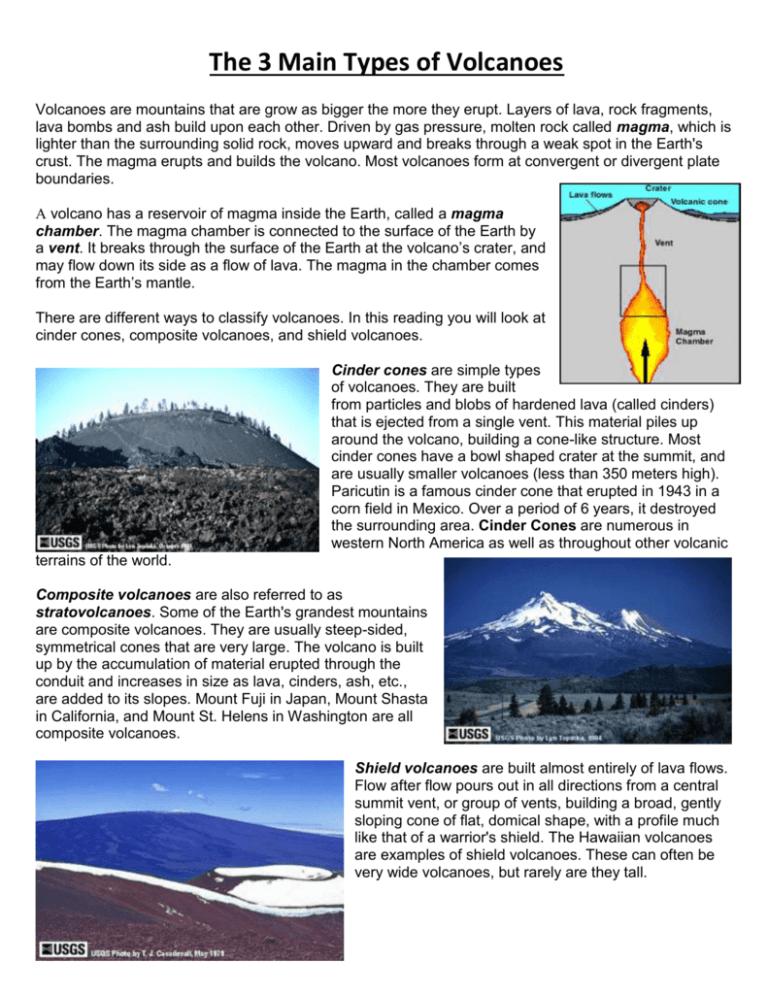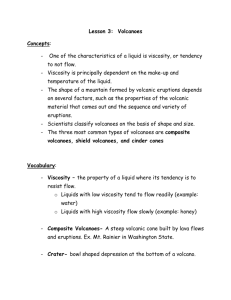Volcanoes_Types_&_Qu..
advertisement

The 3 Main Types of Volcanoes Volcanoes are mountains that are grow as bigger the more they erupt. Layers of lava, rock fragments, lava bombs and ash build upon each other. Driven by gas pressure, molten rock called magma, which is lighter than the surrounding solid rock, moves upward and breaks through a weak spot in the Earth's crust. The magma erupts and builds the volcano. Most volcanoes form at convergent or divergent plate boundaries. A volcano has a reservoir of magma inside the Earth, called a magma chamber. The magma chamber is connected to the surface of the Earth by a vent. It breaks through the surface of the Earth at the volcano’s crater, and may flow down its side as a flow of lava. The magma in the chamber comes from the Earth’s mantle. There are different ways to classify volcanoes. In this reading you will look at cinder cones, composite volcanoes, and shield volcanoes. Cinder cones are simple types of volcanoes. They are built from particles and blobs of hardened lava (called cinders) that is ejected from a single vent. This material piles up around the volcano, building a cone-like structure. Most cinder cones have a bowl shaped crater at the summit, and are usually smaller volcanoes (less than 350 meters high). Paricutin is a famous cinder cone that erupted in 1943 in a corn field in Mexico. Over a period of 6 years, it destroyed the surrounding area. Cinder Cones are numerous in western North America as well as throughout other volcanic terrains of the world. Composite volcanoes are also referred to as stratovolcanoes. Some of the Earth's grandest mountains are composite volcanoes. They are usually steep-sided, symmetrical cones that are very large. The volcano is built up by the accumulation of material erupted through the conduit and increases in size as lava, cinders, ash, etc., are added to its slopes. Mount Fuji in Japan, Mount Shasta in California, and Mount St. Helens in Washington are all composite volcanoes. Shield volcanoes are built almost entirely of lava flows. Flow after flow pours out in all directions from a central summit vent, or group of vents, building a broad, gently sloping cone of flat, domical shape, with a profile much like that of a warrior's shield. The Hawaiian volcanoes are examples of shield volcanoes. These can often be very wide volcanoes, but rarely are they tall. Questions Name: ______________________________ Date: _________________ 1. What kind of slope does a stratovolcano have? 2. Why do they have these types of slopes? 3. How do stratovolcanoes differ from shield volcanoes and cinder cones? 4. How do volcanoes support the idea of plate tectonic theory? 5. Describe pyroclastic flow. From which of the volcanoes describe in this reading would you expect to produce pyroclastic flows? Why do you think this? 6. Based on the differences among volcano types, make a list of at least 4 questions you would ask if you were trying to classify a newly discovered volcano. Super Volcano Will Challenge Civilization, Geologists Warn By Robert Roy Britt, LiveScience Senior Writer posted: 08 March 2005 06:30 am ET The eruption of a super volcano "sooner or later" will chill the planet and threaten human civilization, British scientists warned Tuesday. And now the bad news: There's not much anyone can do about it. Several volcanoes around the world are capable of gigantic eruptions unlike anything witnessed in recorded history, based on geologic evidence of past events, the scientists said. Such eruptions would dwarf those of Mount St. Helens, Krakatoa, Pinatubo and anything else going back dozens of millennia. "Super-eruptions are up to hundreds of times larger than these," said Stephen Self of the United Kingdom's (U.K.) Open University. "An area the size of North America can be devastated, and pronounced deterioration of global climate would be expected for a few years following the eruption," Self said. "They could result in the devastation of world agriculture, severe disruption of food supplies, and mass starvation. These effects could be sufficiently severe to threaten the fabric of civilization." Self and his colleagues at the Geological Society of London presented their report to the U.K. Government's Natural Hazard Working Group. "Although very rare these events are inevitable, and at some point in the future humans will be faced with dealing with and surviving a super eruption," Stephen Sparks of the University of Bristol told LiveScience in advance of Tuesday's announcement. Supporting evidence The warning is not new. Geologists in the United States detailed a similar scenario in 2001, when they found evidence suggesting volcanic activity in Yellowstone National Park will eventually lead to a colossal eruption. Half the United States will be covered in ash up to 3 feet (1 meter) deep, according to a study published in the journal Earth and Planetary Science Letters. Explosions of this magnitude "happen about every 600,000 years at Yellowstone," says Chuck Wicks of the U.S. Geological Survey, who has studied the possibilities in separate work. "And it's been about 620,000 years since the last super explosive eruption there." Past volcanic catastrophes at Yellowstone and elsewhere remain evident as giant collapsed basins called calderas. The eruption pumps dust and chemicals into the atmosphere for years, screening the Sun and cooling the planet. Earth is plunged into a perpetual winter, some models predict, causing plant and animal species to disappear forever. "The whole of a continent might be covered by ash, which might take many years -possibly decades -- to erode away and for vegetation to recover," Sparks said. Yellowstone may be winding down geologically, experts say. But they believe it harbors at least one final punch. Human impact The odds of a globally destructive volcano explosion in any given century are extremely low, and no scientist can say when the next one will occur. But the chances are five to 10 times greater than a globally destructive asteroid impact, according to the new British report. About 74,000 years ago, in what is now Sumatra, a volcano called Toba blew with a force estimated at 10,000 times that of Mount St. Helens. Ash darkened the sky all around the planet. Temperatures plummeted by up to 21 degrees at higher latitudes, according to research by Michael Rampino, a biologist and geologist at New York University. Sitting ducks Based on the latest evidence, eruptions the size of the giant Yellowstone and Toba events occur at least every 100,000 years, Sparks said, "and it could be as high as every 50,000 years. There are smaller but nevertheless huge eruptions which would have continental to global consequences every 5,000 years or so." Unlike other threats to mankind -- asteroids, nuclear attacks and global warming to name a few -- there's little to be done about a super volcano. "While it may in future be possible to deflect asteroids or somehow avoid their impact, even science fiction cannot produce a credible mechanism for averting a super eruption," the new report states. "No strategies can be envisaged for reducing the power of major volcanic eruptions." The Geological Society of London has issued similar warnings going back to 2000. The scientists this week called for more funding to investigate further the history of super eruptions and their likely effects on the planet and on modern society. "Sooner or later a super eruption will happen on Earth and this issue also demands serious attention," the report concludes.







